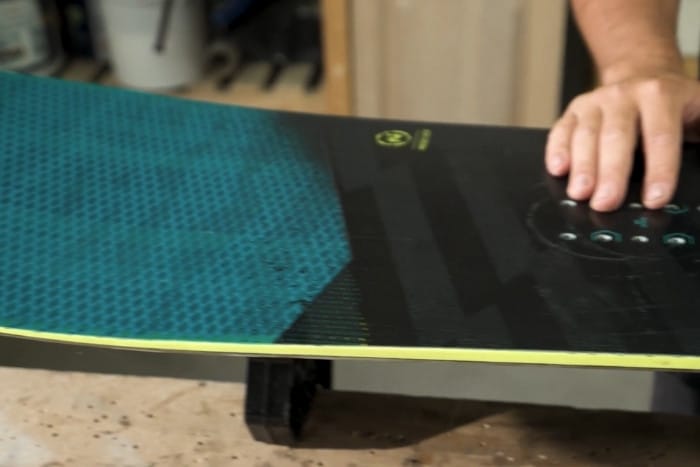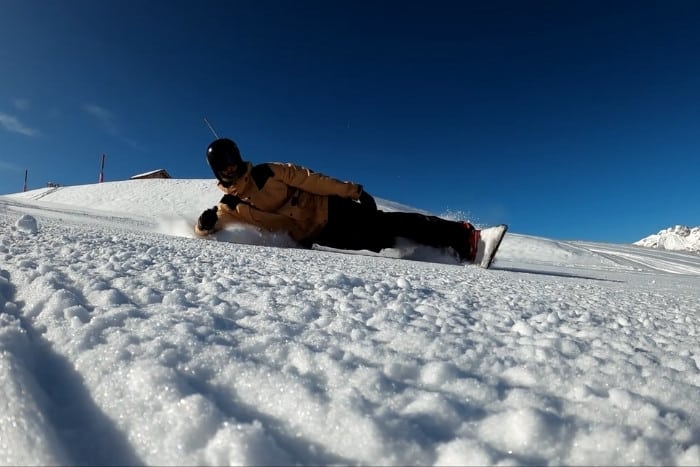There are many different snowboard shapes, and all have specific riding characteristics. For example, a directional snowboard will give you a different riding experience than a twin. If you are considering purchasing a directional snowboard, you need to know the pros and cons.
Directional snowboards are designed to work at their best when riding forwards, making them ideal for backcountry and all-mountain snowboarding. The main downside of these snowboards is that they aren’t best suited for freestyle tricks, as being able to take off and land switch is more challenging.
Choosing between snowboard shapes depends on your preferred riding style and what you want to do on the mountain. A directional snowboard has specific traits that affect your performance in various circumstances. Let’s go into the details.
The Two Types Of Directional Snowboard
Before we get into it, it’s best to explain the two types of directional snowboards.
1. Directional Twin Snowboards
A directional twin snowboard is similar to a twin snowboard but with a slightly different shape to make it more suited to all-mountain riding.
Its shape consists of a symmetrical nose and tail; however, the binding inserts are slightly rearward. These snowboards are designed for riding forwards.
However, you can ride them switch (backward) without too much trouble. But this will depend on your skills, the board’s stiffness, sidecut, and how far back the bindings sit.
You should also be fine riding a directional twin in the park, but a true twin is a better choice for park rats. Most riders who choose a directional twin snowboard like how it performs on groomers and in powder.
This all-mountain design makes directional twin snowboards versatile, allowing you to explore and have fun anywhere on the mountain.
Before you decide that a directional twin is for you, you must know that they come in various guises. For example, they are often built with different flex patterns that make the nose more flexible than the tail.
My current favorite snowboard is a directional twin that somehow magically does everything. This board is part of the new generation of volume-shifted snowboards, which means it’s short and wide.
It holds an edge like no other board I’ve ridden, floats in powder, rides switch well, and is super fun.

2. Directional Snowboards
Directional snowboards are geared up for freeriding more than the other shapes available. Like directional twin snowboards, the binding inserts are set back, bringing your weight closer to the tail and creating a longer nose.
You will find many different shaped directional snowboards, depending on the brand and the board is designed to be used for.
For example, the nose shape may be wider, extra long, or pointy. Also, the shorter tail will usually be stiffer. Some directional snowboards have swallow tails.
These are designed to be ridden in deep powder, as the V-shaped cut-out makes the tail sink into the snow, raising the nose.
Swallow tails also enhance your maneuverability in powder while giving you a surfier feeling.
Pros Of Directional Snowboards
Now you know the two types of directional snowboards, I’ll highlight the best things about them so you know what kind of riding experience to expect when you strap in.
1. Lots Of Float In Powder
One of the best things about directional snowboards is their float in deep powder. Of course, you can ride a twin snowboard in powder, but directional snowboards make the experience more fun and easier.
The float comes from the longer nose, shorter tail, and setback stance. The shape and stance allow the tail to sink into deep snow, keeping the nose up.
This saves you from leaning back as much when riding powder, which quickly tires out your back leg. The raised nose is less likely to dip under the snow, sending you tumbling forwards.
Most freeride snowboards and splitboards have directional shapes, as they are mainly ridden in powder.
The extra float allows you to ride fast, but it also helps you to absorb the impacts from backcountry cliff drops, making it easier to ride away with style rather than sinking and falling over.
2. Dreamy Powder Turns
Sticking with performance in powder, a directional snowboard makes powder turns even more fun. This is another characteristic that comes from the long nose, short tail, and setback stance.
In powder, directional snowboards have a surf-like feeling to them, which is never a bad thing. The short tail also makes them easy to turn quickly and sharply.
This is fun when riding through trees, but it can also get you out of trouble if you need to take action to avoid a hazard. It also means you can slash the powder for epic face shots!
3. They Carve Beautifully On Groomed Slopes
If you’re like me and love the “art of the turn,” a directional snowboard is a great choice. This is because their side cuts get progressively deeper towards the tail, which helps you to ease into each turn.
The deepest part towards the back of the board allows you to use the spring in the tail, firing you into the next turn.
This characteristic makes riding around fun and carves addictive. You’ll want to get lower and dial in those euro-carves as you progress.
4. They Are Fast
As directional snowboards carve so well and are often used for freeriding, they are designed with high performance in mind.
Most directional snowboards have super slippery bases, so they can glide well in all snow conditions.
When you combine a fast base with incredible turning ability, you have a snowboard that will worry most skiers when it comes to speed.
Their superior edge hold allows you to ride aggressively, especially if your directional snowboard has a high stiffness rating.
Cons Of Directional Snowboards
There’s no perfect snowboard shape that will allow you to do everything you want to do on the mountain. Therefore, directional snowboards come with a few minor drawbacks.
1. Switch Riding Can Be Tricky
The fact that directional twins ride differently forwards and backward can be awkward for switch riding, which makes freestyle riding challenging. That doesn’t mean it’s impossible, but it takes getting used to.
Some directional snowboards are easier to ride switch than others, but those with very short tails are more challenging to ride backward.
However, it gets much harder when you ride a swallow tail snowboard.

2. Not as Forgiving As Twin Snowboards
Directional snowboards tend to be stiffer than most snowboards, and this is due to their all-mountain or freeride bias.
Therefore, if you want something more forgiving, make sure your new snowboard has a lower stiffness rating.
3. Not The Best Choice For Beginners
A directional snowboard may not be a good choice if you’re just starting out and still deciding what kind of snowboarding you prefer and need something easy to ride.
Therefore, you’d be better off with a more flexible, all-mountain twin snowboard that can be ridden in many more conditions.
4. They Are Usually Expensive
As directional snowboards are configured more for performance, they tend to sit in higher price brackets. The price is usually increased due to the extra durability required for riding in the backcountry.
Final Thoughts
As you can see, there are some great benefits to riding a directional snowboard, particularly if you love riding powder and the backcountry.
However, a few drawbacks may steer you towards another shape, especially if you’re new to riding.
If you’re looking to purchase a new board and are considering a directional, you must carefully consider what you want from a snowboard to make an informed choice.
